
Position after move 5. Black tries to hang on to the gambit pawn.
White Black 1. d4 e6 Queen pawn opening and black invites a French Defense. 2. c4 Nc6 White wants a queen pawn opening; black's reply is non-standard. 3. Nf3 d5 Black transposes into a double queen pawn opening. 4. Nc3 dxc4 Black accepts the gambit pawn. 5. e4 Na5 White's e4 is recognized in the literature as risky.

6. Ne5 Rb8 7. Nxc4 Nc6 White recovers the pawn but black declines the knight trade. 8. Be3 b5 White's Be3 is natural but probably not the best (see the next game). 9. Ne5 Nxe5 10. dxe5 Qxd1+ 11. Rxd1 a6
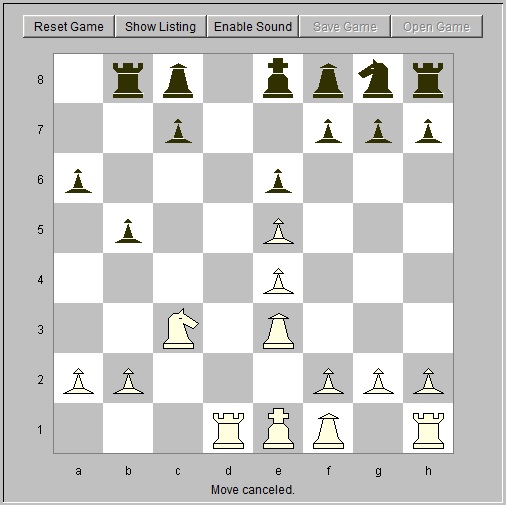
12. Be2 Bb7 13. f3 Be7 14. a3 Nh6 15. Kf2 Rf8
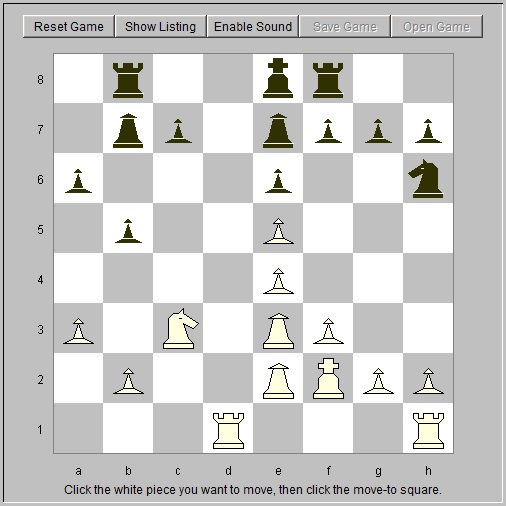
16. Rd2 f5 17. Bd3 Ng4+ Taking the pawn en passant is probably better for white. 18. Ke2 Nxe5 19. exf5 Nxd3 20. Rxd3 Rxf5 21. Rh1d1 Bd6
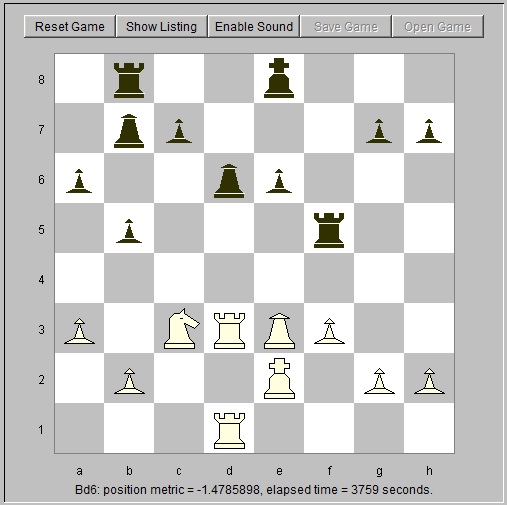
White Black 1. d4 e6 The point of all queen pawn openings is to hold back black's king pawn. 2. c4 d5 Queen's gambit by transposition. Normally, black's first two moves are reversed. 3. Nc3 dxc4 Black accepts the gambit pawn. 4. e4 Nc6 Attacking white's queen pawn in an attempt to hold onto the gambit pawn. 5. Nf3 Na5
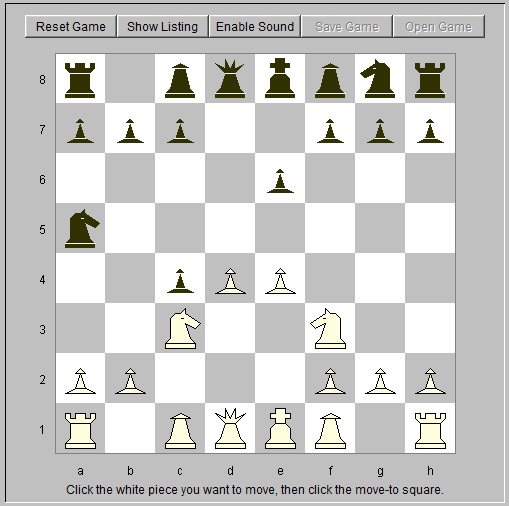
6. Ne5 Rb8 7. Nxc4 Nc6 8. d5! exd5 Advancing the queen pawn is more active than the defensive bishop move in the game above. 9. exd5 Qe7+ 10. Be2 b5 Black's b5 is the point of his 6. ... Rb8.
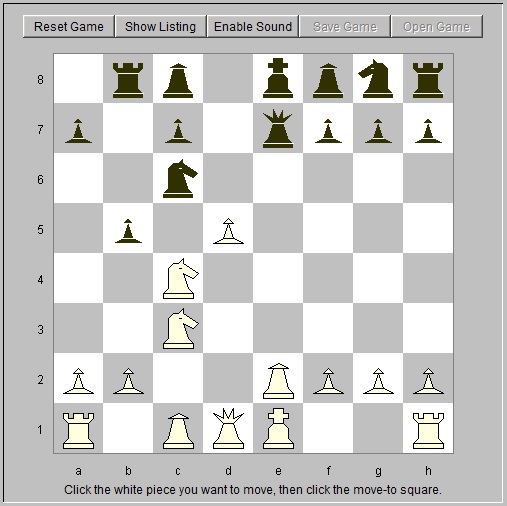
11. Ne3 Nd8 White's knight has a good retreat square. 12. a3 a6 White could have taken black's knight pawn but wanted to avoid exchanging pieces, looking for bigger game. 13. O-O Qh4 14. Re1 Ne7 15. Bf3 b4
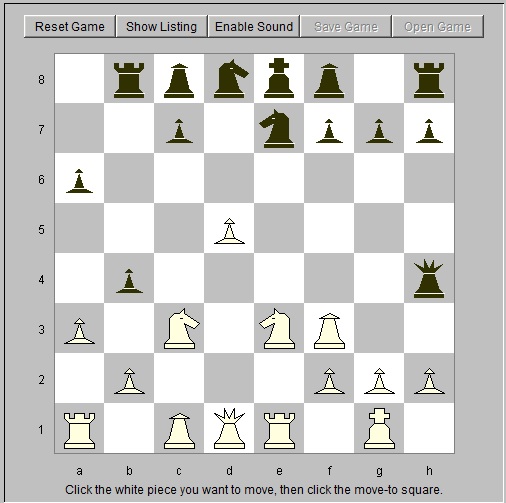
16. axb4 Rb6 Black appears afraid of complications. E.g., Rxb4 or Qxb4, d6 followed by Ne3d5 17. Qd3 Qxb4 White could have protected the pawn, but bigger game is afoot. 18. Ra4 Qc5 19. Rc4 Qa5 20. Rxc7 Rxb2? Black loses a piece.
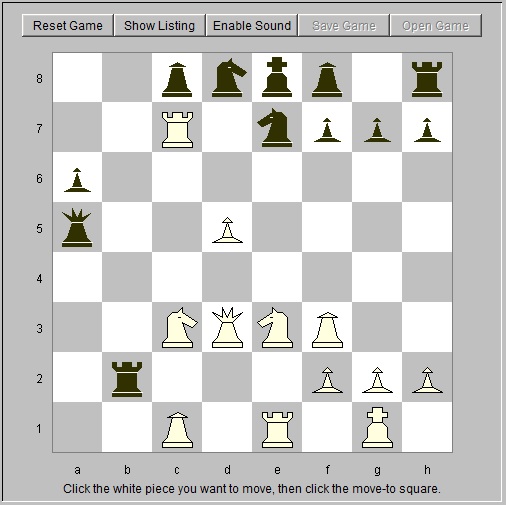
21. Rxc8 Rb4 22. Bd2 Qb6 White has several good moves. 23. Nc4 Rxc4 Black is desperate. 24. Qxc4 Kd7? Unpinning the knight, but out of the frying pan and into the fire. 25. Ra8 h6 Black has little better than this useless pawn move.

26. Qa4+ Ne7c6 27. dxc6+ Nxc6 28. Be3 Qb7 29. Rd1+ Kc7 30. Bf4+ Kb6
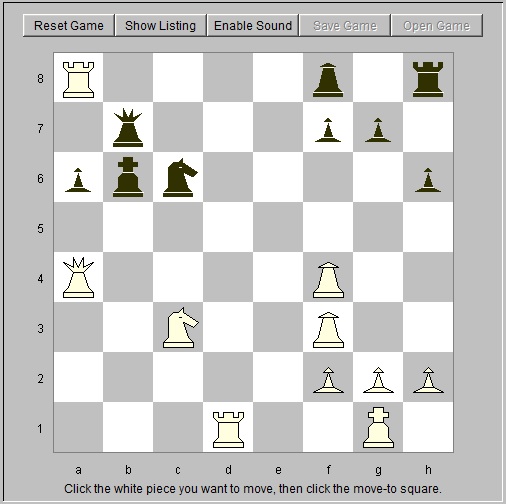
31. Rb1+ Bb4 32. Rxb4+ Black resigns
White Black 1. d4 e6 2. c4 d5 3. Nc3 dxc4 4. e4 Nc6 Again, e4 here is considered risky, e3 being the safe route. 5. Nf3 Na5

6. Ne5 Rb8 White needs to get back the gambit pawn or his game is a pawn down without much compensation. 7. Nxc4 Nc6 8. d5! exd5 9. exd5 Qe7+ 10. Be2 b5
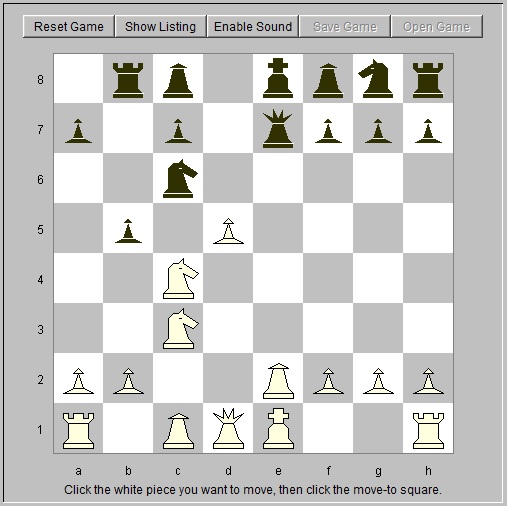
11. Ne3 Nd8 Black's Nd8 is as "good" as anything. 12. Nxb5 Qc5 White takes the pawn, but it leads to a less exciting game than game two above. 13. Nc3 Nf6 14. O-O c6 15. Re1 Be7

16. Bf3 O-O 17. Qa4 cxd5 18. Ne3xd5 Nxd5 19. Nxd5 Bd6 20. Be3 Qb5 21. Qxa7 Qxb2

22. Bd4 Qb5 23. Ne7+ Bxe7 24. Qxe7 Nc6 25. Bxc6 Qxc6 26. Qe5 Qf6 27. Qxb8 Qxd4

28. Qe5 Qxe5 29. Rxe5 Be6 30. a4 Rd8 31. a5 g6 32. a6 Ra8 33. a7 Kg7 34. Rb5 Bf5 35. Rb8 Be4 36. f3 Bd5 37. Rxa8 Bxa8 38. Rb1 Bd5 39. Rb8 g5 40. a8=Q Bxa8 41. Rxa8 h5 White is a rook up and wins easily.
White Black 1. d4 d5 2. c4 e6 3. Nc3 dxc4 4. e4 Nc6 5. Nf3 Na5 6. Ne5 Rb8 7. Nxc4 Nc6 8. d5 exd5 9. exd5 Qe7+ 10. Be2 b5 11. Ne3 Nd8 12. Bxb5+ Bd7 13. Bxd7+ Qxd7 14. O-O Bc5 15. Re1 Kf8 16. Qc2 Ne7 17. b3 h5 18. Bb2 Rh6 19. Ra1d1 h4 20. h3 Rh5 21. Qe2 Rh8 22. Qf3 f6 23. Ne4 Bb4 24. Nxf6 gxf6 25. Bxf6 Bxe1 26. Bxh8+ Kg8 27. Qf6 Bxf2+ 28. Kxf2 Ng6 29. Qxg6+ Kxh8 30. Qf6+ Kg8 31. Qxh4 Qg7 32. Rd4 Qf8+ 33. Kg1 Qd6 34. Qg5+ Kf7 35. Nf5 Qf8 36. Rf4 Qc5+ 37. Kh2 Ke8 38. Rc4 Qf8 39. Rxc7 Ne6 40. dxe6 a6 41. Ng7+ Black resigns
 Email Richard dot J dot Wagner at gmail dot com
Email Richard dot J dot Wagner at gmail dot com
chess.html, this hand crafted HTML file was created July 16, 2016.
Last updated August 29, 2016 by
Rick Wagner. Copyright © 2016, all rights reserved.